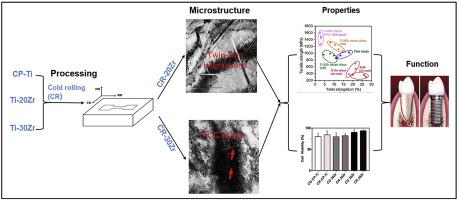Journal of the Mechanical Behavior of Biomedical Materials ( IF 3.9 ) Pub Date : 2020-08-22 , DOI: 10.1016/j.jmbbm.2020.104048 Jie Jiang 1 , Chuan Zhou 2 , Yanwei Zhao 1 , Fuming He 2 , Xiaoxiang Wang 1

|
In this study, two medium Zr-containing Ti-based alloys with commercially pure titanium as control were systematically investigated to assess their potential biomedical application. After samples subjected to TMP and CR, it was found that the Zr addition significantly affected the microstructure, phase constitutions, mechanical properties and cytocompatibility. The microstructural results showed that increasing Zr concentrations resulted in more refined grains. Furthermore, Zr changed the phase constitution: CR Ti–20Zr was formed by the single α-phase while CR Ti–30Zr alloy was formed by the coexistence of α and deformation-induced FCC phases. The P-type FCC phase was dominant and more prone to occur than the B-type one. The mechanical tests demonstrated that the increasing Zr content led to a simultaneous increase in micro-hardness, strength and plasticity of CR samples due to the combined effects of solution strengthening, work hardening and the FCC phase. The SEM fractography indicated that the brittle fracture of CR Ti–20Zr due to deformation twins and ductile fracture of CR Ti–30Zr because of FCC phase. Furthermore, Ti–Zr alloys presented comparable cytocompatibility to the CP-Ti control based on cell viability, proliferation and intracellular O2− content of MSCs. Specifically, alkaline phosphatase activity in BMSCs were significantly higher for grain refined CR Ti–30Zr. Considering all these results, CR Ti–30Zr alloy exhibited the optimal comprehensive performance to be potential dental materials.
中文翻译:

牙科Ti-Zr二元合金的开发和性能。
在这项研究中,系统地研究了两种以商业纯钛为对照的中等Zr含Ti的Ti基合金,以评估其潜在的生物医学应用。在对样品进行TMP和CR处理后,发现Zr的添加会显着影响微观结构,相组成,机械性能和细胞相容性。显微组织结果表明,增加的Zr浓度会导致晶粒更加细化。此外,Zr改变了相组成:CR Ti–20Zr由单个α相形成,而CR Ti–30Zr合金由α和变形引起的FCC相共存而形成。P型FCC相占主导地位,比B型相更容易发生。机械测试表明,Zr含量的增加导致显微硬度的同时增加,由于固溶强化,加工硬化和FCC相的综合作用,CR样品的强度和可塑性。SEM形貌表明,由于变形孪晶引起的CR Ti-20Zr脆性断裂和由于FCC相引起的CR Ti-30Zr的韧性断裂。此外,基于细胞活力,增殖和细胞内O,Ti-Zr合金具有与CP-Ti对照相当的细胞相容性MSC的2-内容。具体来说,对于谷物精制的CR Ti-30Zr,BMSC中的碱性磷酸酶活性明显更高。考虑到所有这些结果,CR Ti-30Zr合金表现出最佳的综合性能,成为潜在的牙科材料。



























 京公网安备 11010802027423号
京公网安备 11010802027423号